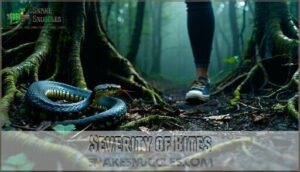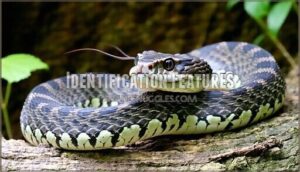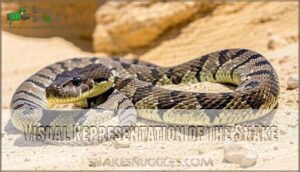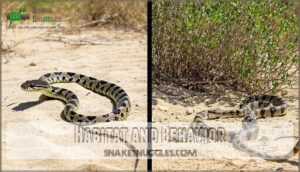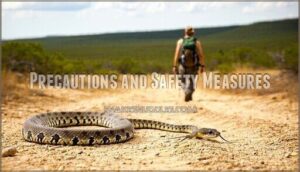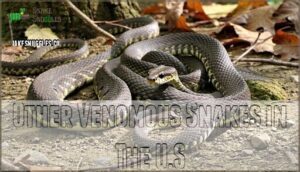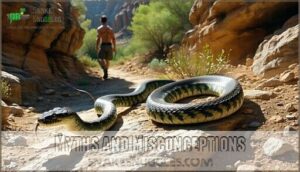This site is supported by our readers. We may earn a commission, at no cost to you, if you purchase through links.
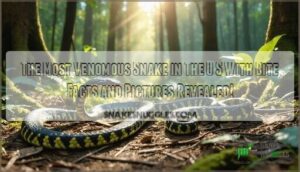
This reptile’s rugged diamond-shaped patterns shimmer like jewels in the sun as it silently winds through southeastern forests and thick palmetto undergrowth. You’ll want to keep your distance; one rattle means business!
The most venomous snake in the u s with bite facts and pictures is just a few steps away from you—sometimes, literally. Stay tuned for life-saving tips.
Table Of Contents
Key Takeaways
- You’ll find the most venomous snake in the U.S., the eastern diamondback rattlesnake, in the Southeast, where its powerful venom and bold markings make it easy to identify.
- If you’re bitten, symptoms like swelling, pain, and breathing trouble can hit fast, so quick medical attention is critical.
- Always watch for the snake’s triangular head and diamond-shaped patterns, and listen for its warning rattle to steer clear out on the trail.
- You can avoid dangerous encounters by sticking to marked paths, wearing snake-proof gear, and respecting their space in the wild.
The Most Venomous Snake in The U.S
You’ll find the most venomous snake in the U.S.—the Eastern diamondback rattlesnake—across the Southeast, where its reputation for powerful venom puts it at the top.
With keen senses and distinctive markings, this species stands out not just for its potent bite, but also its impressive size and adaptability.
Venom Potency
One big thing to know about venom potency: it’s not just about how much, but how strong the mix is. When a venomous snake bites you, its fangs work like nature’s syringes, injecting a cocktail of toxins that target your nerves and muscles. Venom Composition and Toxicity Levels, measured by LD50, determine bite severity.
Here are three things you should know:
- Venom Delivery directly affects Bite Severity.
- Potency Factors include volume and toxin type.
- Some snakes have dangerously high LD50 scores. Understanding snake bite symptoms is essential for effective treatment.
Geographic Distribution
You’ve just learned about the Eastern diamondback’s powerful venom, but where do these snakes actually roam? Their geographic range spins across the Southeast, from North Carolina to eastern Louisiana, dipping deep into Florida’s wild heart.
The eastern diamondback rattlesnake thrives in habitats like pine forests, coastal dunes, marshes, and swamps. Regional maps show climate shift, habitat loss, and even snake migration patterns play big roles in geographic isolation and population changes.
In short, this venomous snake’s distribution isn’t random—it’s nature’s blueprint for survival.
Physical Characteristics
After exploring where the eastern diamondback rattlesnake can be found, let’s focus on its physical characteristics that make it truly one of a kind. Notice the triangular-shaped head, elliptical pupils, and its thick body proportions. Look closely and you’ll spot distinct scalation patterns and signature color morphs. The snake’s scales shimmer in sunlight and it can sense warmth through specialized heat-sensing pits.
- Always check for these identification features when in venomous snake country—they’ll save you guesswork.
Bite Facts and Symptoms
If you’re bitten by the Eastern diamondback rattlesnake, you’ll notice symptoms fast—pain, swelling, and trouble breathing may set in within minutes.
Quick medical care is critical, so don’t wait or try old home remedies if you find yourself facing this scaly surprise.
Severity of Bites
After learning which snake sits at the top of the venom charts, you’ll want to know what happens if you’re bitten. The bite severity is no joke—symptoms often hit fast and hard. Swelling, intense pain, and even trouble breathing might set in before you can say “venom potency.”
Not all bites are the same—how your body reacts depends on the snake venom dose and your own health. Emergency response and up-to-date toxicology research both help turn scary bite facts into survivable situations.
Envenomation Effects
When considering bite severity from a highly venomous snake, you’ll notice envenomation symptoms like sudden pain, redness, and swelling around the bite. Venom toxicity strikes quickly—leading to symptoms like nausea or even breathing problems.
Sometimes, envenomation effects are sneaky, so don’t shrug off any weird feelings. Watch for:
- Progressing bruising or blistering around the wound
- Difficulty swallowing or speaking
- Heavy sweating or chills
Snake bites pack a punch, and fast medical treatment paired with proper antivenom efficacy is your lifeline.
First Aid and Treatment
After understanding the body’s reaction to a bite, it’s time to focus on quick first aid and treatment. Acting fast can mean the difference between a story to tell and a trip to the ER.
- Seek Emergency Response without delay.
- Snap a safe photo of the snake.
- Begin Wound Cleaning, skip Snake Bite Kits.
- Antivenom Administration and Pain Management follow in hospital care.
It’s vital to follow proper emergency medical protocols to ensure effective treatment.
Pictures of The Venomous Snake
You’ll find detailed photographs that clearly show the Eastern diamondback rattlesnake’s distinctive diamond-shaped markings and heat-sensing facial pits. These visual guides help you identify key features like the triangular head, thick body, and prominent rattle that distinguish this dangerous species from harmless snakes.
Identification Features
Several key features help you identify the Eastern diamondback rattlesnake, America’s most venomous snake. You’ll notice its distinctive triangular head shape and elliptical pupils that distinguish it from harmless species. Heat pits between the eyes and nostrils detect warm-blooded prey, making this snake a formidable predator. The coloration markings feature dark diamond patterns against lighter backgrounds, while scale patterns create a rough texture. Most importantly, you’ll hear its warning rattle before seeing the snake.
Key identification features that could save your life:
- The diamond-shaped scale patterns along its back create an unmistakable warning sign
- Heat pits act like thermal cameras, helping the snake strike with deadly accuracy
- Rattle characteristics include multiple segments that buzz loudly when threatened
Understanding these physical characteristics and identifying features helps prevent dangerous snake bite encounters. Venomous snake identification requires recognizing these specific traits, as the venom potency makes proper identification essential for your safety.
Visual Representation of The Snake
You’ll recognize the Eastern diamondback by its distinctive diamond-shaped body markings and triangular-shaped head. These color variations range from grayish-brown to yellowish-brown, creating perfect camouflage techniques against sandy terrain. Scale patterns feature darker diamond outlines, while elliptical pupils distinguish this species from harmless snakes.
| Physical Characteristics | Identifying Features | Venomous Snake Identification |
|---|---|---|
| Triangular head shape | Diamond body markings | Heat-sensing pits |
| Thick, muscular body | Keeled scales | Elliptical pupils |
| Distinctive rattle | Brown/gray coloration | Fangs visible when mouth opens |
| 3-8 feet length | Blotched patterns | Single row of belly scales |
Habitat and Behavior
You’ll find the Eastern diamondback rattlesnake thriving in southeastern coastal areas, pine forests, and sandy scrublands where it hunts small mammals and birds.
This solitary predator uses heat-sensing pits to locate prey and remains relatively inactive during cooler months, becoming more aggressive during mating season in spring.
Natural Environment
You’ll find Eastern diamondback rattlesnakes thriving in southeastern U.S. habitats where Climate Influence shapes their Geographic Distribution. These serpents call diverse ecosystems home, each playing an important Ecosystem Role:
- Pine flatwoods and scrublands – sandy, well-drained areas
- Coastal dunes and barrier islands – salt-tolerant vegetation zones
- Palmetto thickets and wiregrass prairies – dense undergrowth for cover
Their Habitat preferences span Florida, Georgia, and the Carolinas, where they’ve adapted to specific environmental conditions.
However, Habitat Destruction threatens their Geographic Range greatly. Conservation Strategies focus on Habitat Preservation to maintain Biodiversity Impact across these regions.
Hunting and Feeding Habits
Eastern diamondback rattlesnakes showcase impressive Hunting Techniques as ambush predators. Their Prey Selection includes rabbits, squirrels, and birds. Hunting Patterns involve patient waiting near trails or burrows.
When striking, their Venom Potency and Venom Strength quickly immobilize victims through massive Venom Load delivery.
Feeding Frequency occurs every few weeks, with the Digestion Process taking days to weeks depending on meal size. These Feeding Habits boost energy efficiency in their demanding environment.
Reproduction and Life Cycle
After understanding their hunting patterns, you’ll find that reproduction follows predictable cycles. Eastern diamondback rattlesnakes reach sexual maturity around three to five years old. Mating Rituals occur during spring when males compete through combat dances. The Gestation Period lasts approximately six to seven months before females give birth to live young. Hatchling Survival depends on immediate independence since mothers provide no care. Reproductive Threats include habitat loss affecting breeding sites, while Lifespan Factors like predation and human activity impact population growth. Conservation Efforts focus on protecting breeding areas within their Geographic Distribution.
Key reproductive facts about this Venomous snake:
- Females produce 10-20 offspring every two to three years
- Young snakes are born with fully functional venom and fangs
- Breeding success varies markedly based on available prey and suitable Habitat and Behavior conditions
- Temperature affects development timing, with cooler conditions extending gestation
- Adult females may skip reproductive years during resource-scarce periods
Precautions and Safety Measures
You can’t predict when you’ll encounter the Eastern diamondback rattlesnake in its southeastern habitat, so preparation becomes your best defense against potentially fatal encounters.
Understanding proper safety protocols and response techniques greatly reduces your risk of a dangerous bite that could deliver up to 450 mg of venom.
Avoiding Encounters
When hiking trails become home to venomous snakes, smart trail awareness keeps you safe. Practice hiking safety by staying on marked paths and avoiding thick brush where snakes hide.
Snake education helps you recognize warning signs like rattling sounds or coiled postures. Regular yard maintenance reduces encounters by clearing debris piles and tall grass.
Always supervise pets in snake-prone areas, as pet protection requires constant vigilance. These safety measures transform potentially dangerous snake sightings into manageable situations through proper precautions and awareness.
Protective Clothing and Gear
Choosing proper protective clothing and gear acts as your first line of defense against snake bites. Snake-proof boots with puncture-resistant materials shield your feet and ankles from fangs. Thick denim or canvas pants create barriers, while long sleeves protect exposed arms.
Gaiter options like leather or Kevlar chaps cover vulnerable lower legs effectively. Quality glove materials including thick leather help during outdoor work. Don’t forget eye protection when moving through dense brush where branches might force sudden movements.
These clothing layers and safety measures greatly reduce bite risks during outdoor activities.
Proper Response to Snake Sightings
When you spot a snake, maintaining Safe Distancing becomes your first priority. Back away slowly without sudden movements that might provoke the animal.
Developing Identification Skills helps determine if you’re facing a venomous species, but don’t get close enough to play detective.
Reporting Sightings to local wildlife authorities protects your Community Awareness efforts. Never attempt snake removal yourself—Professional Removal services handle these situations safely.
Remember, most snake encounters end peacefully when you give them space to retreat.
Conservation Efforts and Threats
You’ll find that threats to the most venomous snake in the U.S. often come from habitat destruction and fragmentation as people expand into wild areas.
Conservation groups work to balance these changes, aiming to protect both the species and the natural environments they call home.
Human Impact on Snake Populations
A surprising domino effect happens when people move into wild spaces—this “human encroachment” chips away at snake numbers. Habitat loss, climate change, and pollution effects keep tipping the scales, pushing these reptiles to the brink.
Your choices help shape outcomes: champion conservation initiatives and habitat restoration, and you’ll be backing both snakes and their ecosystems. Smart conservation strategies make sure future generations get to admire these essential animals.
Habitat Destruction and Fragmentation
After looking at the ripple effects of human impact on snake populations, let’s talk about what really chips away at their numbers: Habitat Destruction and Fragmentation. When land gets broken up by roads or buildings, snakes lose their turf. This doesn’t just fuel Species Decline but also disrupts the entire ecosystem.
To combat Habitat Loss, here are three key Conservation Strategies:
- Restore damaged habitats
- Build wildlife corridors
- Promote eco-friendly land practices
Conservation Initiatives and Organizations
Regarding conservation, it’s all about teamwork—because you can’t restore a habitat or save a species solo. Conservation initiatives work on protecting venomous snake populations by balancing Habitat Preservation and Species Protection with research and Public Awareness. Want a better look? Here are four key efforts:
- Habitat Restoration in threatened zones
- Funding Allocation for field research and recovery
- Research Programs to track Conservation Status
- Boosting community knowledge about Human Impact on Snake Populations
These conservation efforts are the backbone of healthy ecosystems.
Other Venomous Snakes in The U.S
You’re likely to find more than just one type of venomous snake across the United States, with several species each adapted to specific environments. While they aren’t usually looking for trouble, it helps to know that copperheads, cottonmouths, and rattlesnakes all play important roles in their native habitats.
Diversity of Venomous Snakes
Although each region in the U.S. has its own cast of venomous snake species, you’ll notice fascinating differences if you pay attention to Species Identification, Venom Potency, and Evolutionary Adaptations. From copperheads in woodlands to rattlesnakes in deserts, their venom composition shifts with geography.
The table below highlights key differences:
| Species | Venom Composition |
|---|---|
| Eastern Diamondback | Powerful hemotoxins |
| Coral Snake | Potent neurotoxins |
| Copperhead | Mild hemotoxins |
| Cottonmouth | Aggressive cytotoxins |
Understanding these nuances deepens your appreciation for regional variations and Conservation Status.
Common Species and Their Characteristics
Now that you know about snake diversity, it’s time to meet the heavy hitters found slithering across the U.S. If you’re curious about Snake Identification or just want to brush up on your Bite Facts, check out these venomous snake species with unique traits:
- Eastern Diamondback Rattlesnake: massive and packed with potent venom.
- Timber Rattlesnake: famous for its warning rattle and wide Geographic Distribution.
- Copperhead: boasts striking Physical Adaptations and unique Behavioral Traits.
- Cottonmouth: prefers swamps, ready to defend its turf.
- Coral Snake: secretive, vibrant, and highly toxic.
Myths and Misconceptions
You might be surprised by how many stories about venomous snakes just aren’t true. Let’s take a closer look at some common misconceptions so you can recognize fact from fiction with confidence.
Separating Fact From Fiction
Other venomous snakes in the U.S. often get mixed up in stories, making Snakebite Myths grow bigger than the actual snakes. You might hear that every bite is instantly deadly, but in reality, most snake bites aren’t fatal, thanks to fast medical care and accurate Venomous Identification. Don’t let wild Media Portrayals or old campfire tales cloud your judgment—understanding true Aggression Levels and actual Bite Facts helps cut through common Misconceptions.
| Myth | The Fact |
|---|---|
| All bites kill | Few bites are fatal |
| All chase people | Most avoid humans |
| Big = deadly | Venom Potency varies by species |
| Movies show truth | Exaggerated Media Portrayals |
Common Myths About Venomous Snakes
Let’s put myths and misconceptions about venomous snakes to rest. Many people think these snakes are always hunting humans, but that’s simply not true. You don’t need magic tricks or old wives’ tales to stay safe—just sound science. Watch out for these common bites of misinformation:
- Snake Aggression is greatly exaggerated.
- Humans have no Venom Immunity.
- Snake Charming works only in movies.
- Suction Devices won’t remove venom.
- Whiskey Cures are pure fiction.
Frequently Asked Questions (FAQs)
How do antivenoms work to neutralize venom?
When you get antivenom, it acts like a lock for the venom’s key, sticking to the toxins and stopping them from causing more harm.
This helps your body clear the venom and get you back on your feet.
Can domesticated animals survive venomous snake bites?
Like a bolt from the blue, a snake bite can knock your pet’s health off course—fast. Even with treatment, survival depends on the snake’s species, bite location, venom dose, and how quickly you seek veterinary care.
What is the economic impact of snake bites?
Snake bites can hit your wallet hard, piling up medical expenses, lost workdays, and even livestock loss.
Hospitals charge thousands for treatment, while the cost of antivenom bumps the bill even higher—talk about adding insult to injury!
Are children more at risk from venomous bites?
Kids are more at risk from venomous bites because their smaller bodies absorb venom faster. If a bite happens, act quickly—every minute counts.
Don’t wait for symptoms; get medical help right away, just to be safe.
How are venomous snake populations monitored scientifically?
Counting snakes isn’t rocket science, but researchers track populations by using radio transmitters, mark-recapture studies, foot surveys, and even trail cameras.
You’ll see scientists slither through habitats, checking data like snake census-takers with scales.
Conclusion
Worried this topic is too scary? Remember, learning about the most venomous snake in the U.S. with bite facts and pictures helps you stay safe while exploring wild places.
With knowledge of key traits and quick responses, you’re better prepared for those rare but possible encounters. Understand their habitat, symptoms, and safety tips so you can enjoy nature confidently.
Stay aware, respect their space, and you won’t just survive—you’ll thrive outdoors.
- https://en.wikipedia.org/wiki/Eastern_diamondback_rattlesnake
- https://www.bondarms.com/top-10-deadliest-snakes-north-america/
- https://worldpopulationreview.com/state-rankings/snake-bite-statistics-by-state
- https://pubmed.ncbi.nlm.nih.gov/33046301/
- https://www.poison.org/articles/coral-snake-bite-treatment-203

